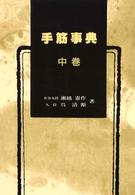Segoe Tesuji Dictionary
Segoe Tesuji Dictionary (手筋事典) is a three volume tesuji, problem book-set collecting almost 1,000 problems, written by Segoe Kensaku and Go Seigen. First published in 1971 by Seibundo Shinkosha as a two-volume set (pink and white cover, with a different kanji 辞典). New edition in three volumes, depicted in the photo, was published in 2003.
It is divided into sections according to the kind of move needed for the tesuji (e.g., tsuke or geta). In each section there are problems, put into three difficulty categories. The C category is comprised of "bread and butter" tesuji that everybody is expected to know. The B category is comprised of more difficult reading problems that, nevertheless, do occur frequently in games. The A category is comprised of much harder problems, requiring deep reading to penetrate. The answers are contained at the back of the volume.
Available from a variety of places including Kiseido, ![[ext]](images/extlink.gif) Amazon Japan (the ISBN numbers come in handy), and
Amazon Japan (the ISBN numbers come in handy), and ![[ext]](images/extlink.gif) Kinokuniya Bookstores. Also see /Discussion and Fujisawa Tesuji Dictionary.
Kinokuniya Bookstores. Also see /Discussion and Fujisawa Tesuji Dictionary.
Tables of Contents
(the 1st edition had slightly more problems - probably dubious ones were omitted in the new edition)
Volume 1:
- tsuke pages 7 - 32, 97 problems
- hasamitsuke pages 33 - 51, 72 problems
- tobitsuke pages 53 - 56, 12 problems
- hanazuke pages 57 - 60, 12 problems
- tsukekoshi pages 61 - 72, 41 problems
- oki pages 73 - 96, 90 problems
Volume 2
- warikomi pages 7-29, 86 problems
- kiri pages 31 - 52, 83 problems
- hane and osae pages 53 - 71, 72 problems
- kosumi pages 73 - 90, 67 problems
- kosumitsuke pages 91 - 95, 14 problems
- sagari pages 97 - 104, 26 problems
Volume 3
- geta pages 9 - 23, 53 problems
- shicho pages 25 - 29, 16 problems
- watari pages 31 - 44, 49 problems
- suteishi (捨て石) pages 45 - 56, 42 problems
- me wo kaku (目を欠く[2]) pages 57 - 68, 42 problems
- sayudokei (左右同型) pages 69 - 72, 12 problems
- atekomi pages 73 - 80, 26 problems
- oiotoshi pages 81 - 85, 16 problems
- damezumari pages 87 - 90, 8 problems
- shibori pages 91 - 96, 15 problems
- oshitsubushi pages 97 - 99, 8 problems
- tobi pages 101 - 104, 10 problems
- misc. tesuji(その他) pages 105 - 111, 23 problems
Sample Material
Reviews
to be added
Notes
[1] Older editions come in two, larger volumes of 325 pages and 342 pages.
[2];: Fhayashi:(Is the Japanese pronunciation right?)
- Velobici: well, I basically dont know any Japanese. And they have this funny way of attaching multiple pronounciations to a single kanji.
- Fhayashi: I can understand meaning, but I'm not clear of the pronounciation. It seems to me that it can be read "me o nuku" or something like that. It's like "pull out the eyes"...
- John F. Me wo kaku, and no, it's not the meaning you think. It's "to lack eyes, have a false eye". The subject is the eye-lacker not the stealer.
- Velobici: John F., does one pronounce the w in を here? I had heard that when を is used as a direct object marker the w is silent. Or is it a convention to write the w even if its not pronounced?
- John F. This is just a habit of mine because I handle classical Japanese where wo is an important letter (e.g. man is wotoko, not otoko). But I think a good case can be made for using it regularly (as some teachers do). Though the w is not pronounced, I think it stops you putting a
![[ext]](images/extlink.gif) glottal stop there. And if you hear a Japanese say combinations like mono wo, or o wo oou, you may say there's a w there anyway. The Japanese w is a lot looser than ours even in wa. Unless you're used to it, you may hear kawa as kaa.
glottal stop there. And if you hear a Japanese say combinations like mono wo, or o wo oou, you may say there's a w there anyway. The Japanese w is a lot looser than ours even in wa. Unless you're used to it, you may hear kawa as kaa.
- iopq Most people don't pronounce it, but sometimes it is pronounced. So you could say there is some variation. But it's good to write wo because then it is easy to see that it is a grammatical marker.
- Fhayashi: I can understand meaning, but I'm not clear of the pronounciation. It seems to me that it can be read "me o nuku" or something like that. It's like "pull out the eyes"...
[3] Thomas Hsiang, ama 7d, called this book "the quickest way to shodan" (see: /Discussion)
[4] tchan001 The Japanese edition is mostly out of print. There is also a Taiwanese edition.



![Sensei's Library [Welcome to Sensei's Library!]](images/stone-hello.png)